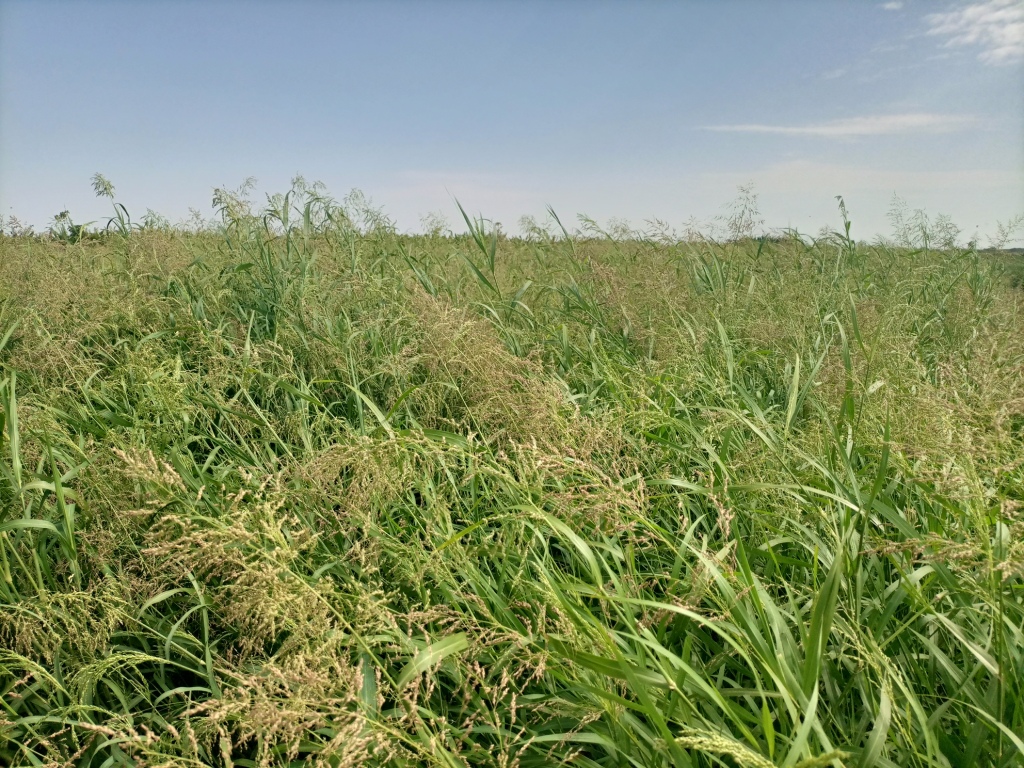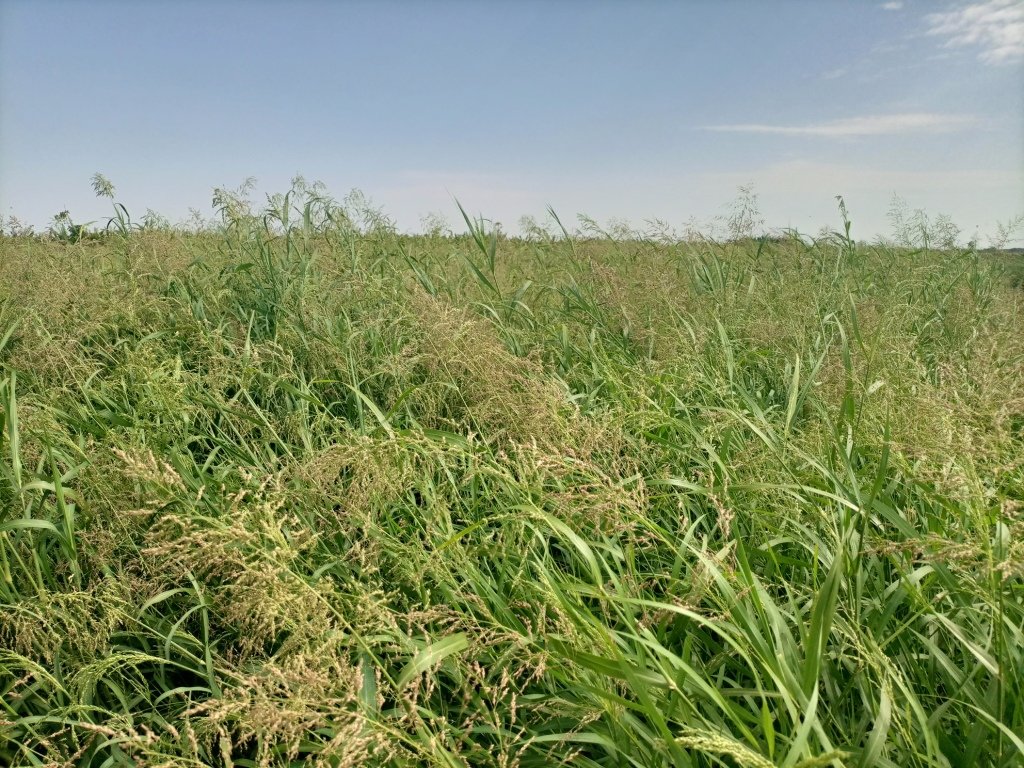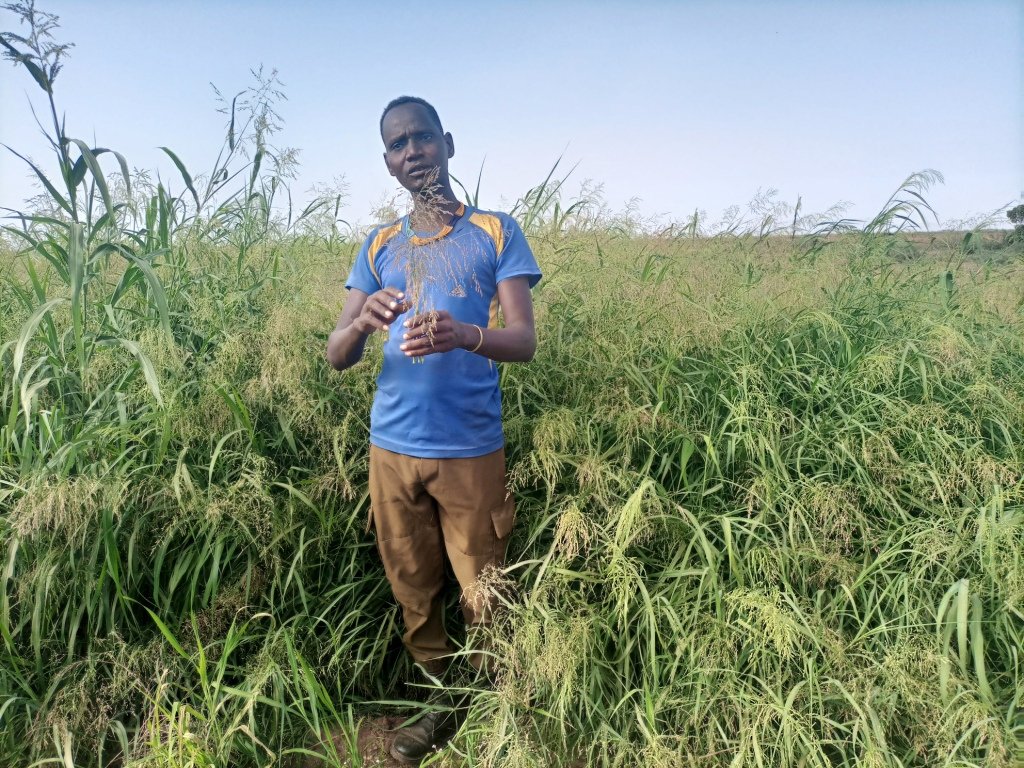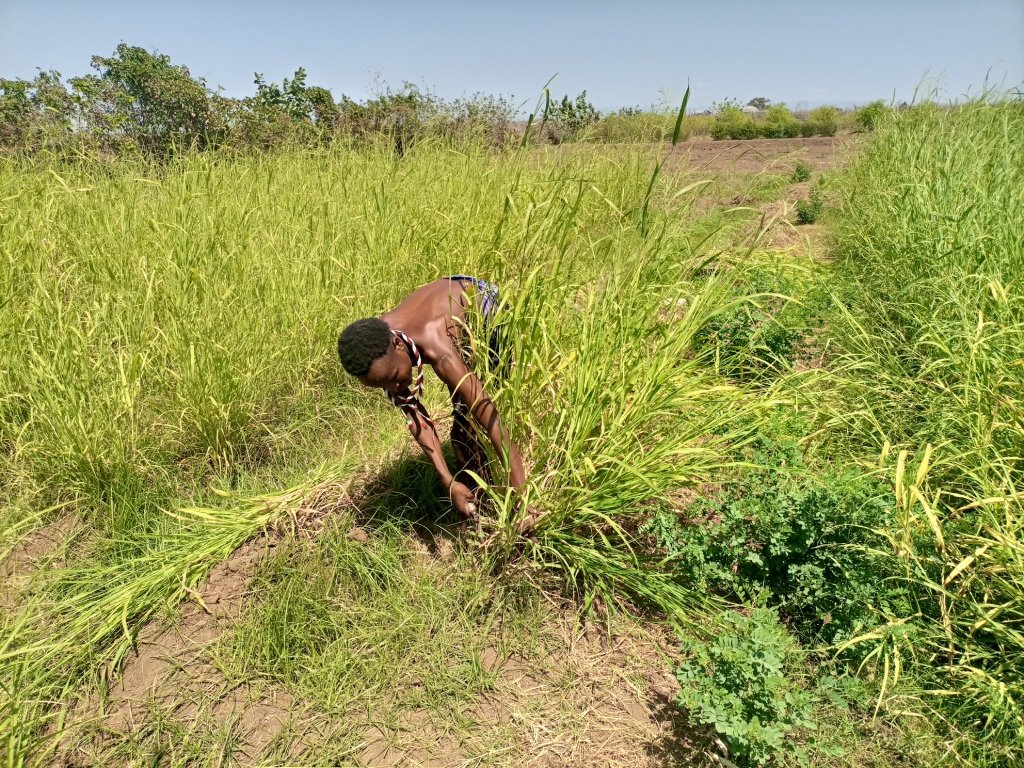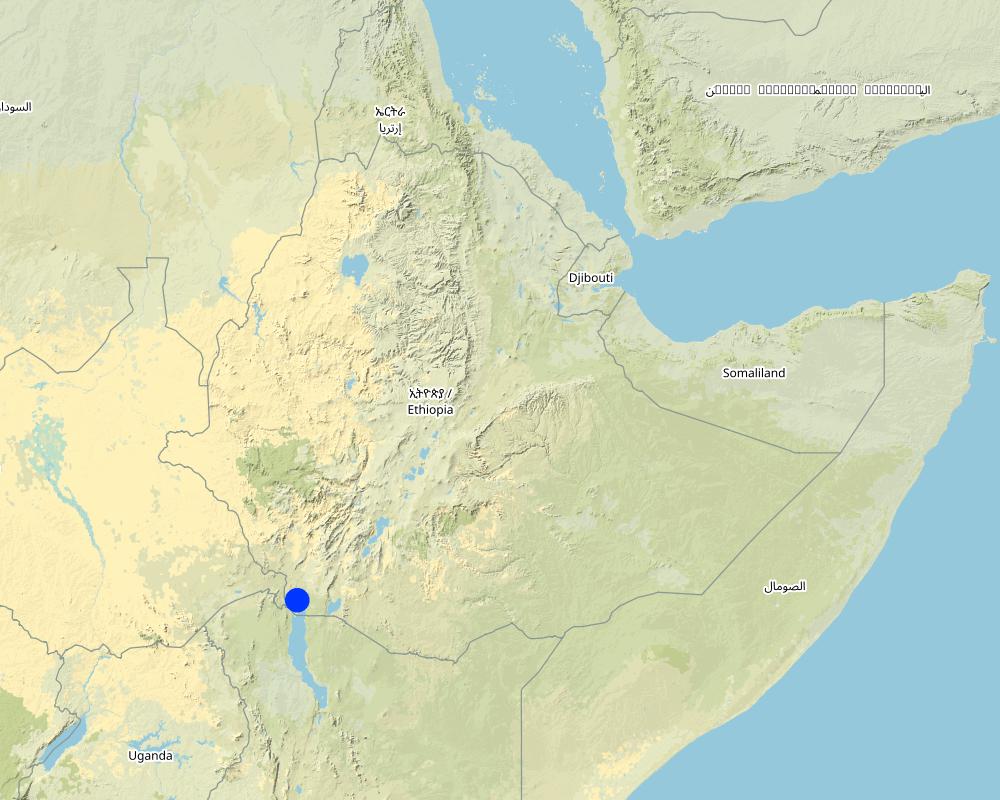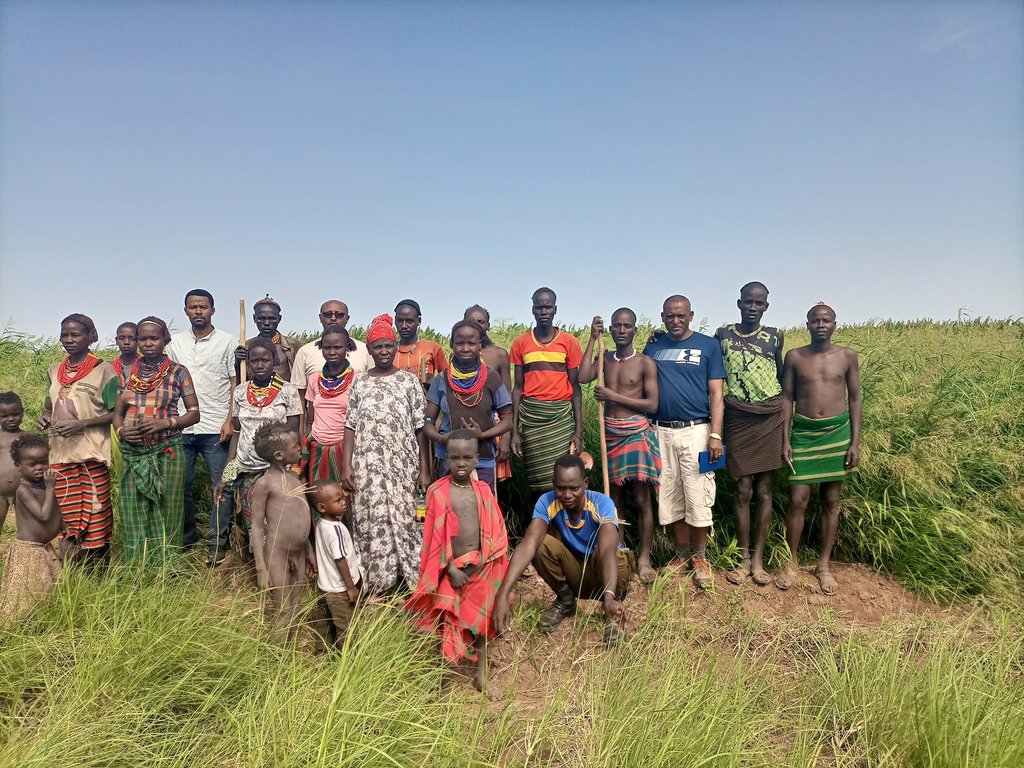Panicum coloratum for irrigated fodder [Ethiopie]
- Création :
- Mise à jour :
- Compilateur : GERBA LETA
- Rédacteur : –
- Examinateurs : Rima Mekdaschi Studer, William Critchley
Panicum
technologies_6563 - Ethiopie
Voir les sections
Développer tout Réduire tout1. Informations générales
1.2 Coordonnées des personnes-ressources et des institutions impliquées dans l'évaluation et la documentation de la Technologie
Personne(s)-ressource(s) clé(s)
exploitant des terres:
Lutulya Abebe
Agro-pastoralist (fodder producers group leader)
Ethiopie
Nom du projet qui a facilité la documentation/ l'évaluation de la Technologie (si pertinent)
Resilient in Pastoralist Areas (RIPA)Nom du ou des institutions qui ont facilité la documentation/ l'évaluation de la Technologie (si pertinent)
International Development Enterprises - Ethiopia (iDE-Ethiopia) - Etats-Unis1.3 Conditions relatives à l'utilisation par WOCAT des données documentées
Le compilateur et la(les) personne(s) ressource(s) acceptent les conditions relatives à l'utilisation par WOCAT des données documentées:
Oui
1.4 Déclaration sur la durabilité de la Technologie décrite
Est-ce que la Technologie décrite ici pose problème par rapport à la dégradation des terres, de telle sorte qu'elle ne peut pas être déclarée comme étant une technologie de gestion durable des terres?
Non
Commentaires:
The technology is a regenerative practice friendly to the environment.
2. Description de la Technologie de GDT
2.1 Courte description de la Technologie
Définition de la Technologie:
Panicum coloratum is a palatable tropical grass with high biomass production potential. It is grown in the irrigated fodder development areas of Dassenech district. Panicum is a fast-growing perennial which can be repeatedly harvested once it reaches maturity. It mitigates the issues of recurrent livestock feed shortage in dry periods – which are becoming worse with climate change.
2.2 Description détaillée de la Technologie
Description:
Irrigated fodder production is carried out by pastoralist groups in arid areas of South Omo. Among a number of fodder grasses, Panicum coloratum is a fast-growing species. Panicum is grown as livestock fodder, particularly for the dry season when feed availability is in short supply. It mitigates the issues of recurrent livestock feed shortages which are becoming worse with climate change. Also, growing fodder grass allows resource-poor pastoralist communities to generate income from the sale of fresh fodder, hay, and seed. Irrigating at least twice a week, good weed management, and fertilization ensure sustained production.
In Dassenech district of Southwest Ethiopia, Panicum’s annual fresh biomass and dry matter production potential is over 63 and 18 tons/ha, respectively. It can reach its first harvest after about 60 days and subsequently can be harvested every 45 days. Panicum germinates and establishes readily on any soil type under both irrigated and rainfed conditions. It is also drought tolerant and resilient to climate variability, and does particularly well on alluvial soils with high fertility. Panicum is mainly used for grazing, but it is also suitable for cut-and-carry feeding systems. Each member of the pastoralist group grows panicum on 0.04 ha of land. In the flood lowlands of the Omo River basin, panicum is known for tolerating periodic flooding, salinity, & disease.
Previously, the land users were unfamiliar with this particular grass and its associated management practices. Also, irrigating on a regular schedule and keeping the grass free from roaming animals adds a work burden to the pastoralist community. However, the Resilience in Pastoral Areas (RIPA) project has introduced and familiarized the community with fodder production and management practices. The project also assists in linking the output to sustainable market. In this regard, the contribution of the RIPA project of the International Development Enterprises (iDE) is immense. The pastoralists appreciate their livestock’s access to year-round feed, as well as the generation of income from the sale of fresh fodder, hay, and seed. Fodder production also creates year-round employment opportunity. However, the community's reliance on government and civic organization support for land preparation and access to irrigation water (conveyance services) might be considered a threat to ensuring sustainability of fodder development by the pastoralist groups.
2.3 Photos de la Technologie
Remarques générales concernant les photos:
The photos display panicum seed and feed harvesting.
2.4 Vidéos de la Technologie
Commentaire, brève description:
Videos of the technology is not documented.
2.5 Pays/ région/ lieux où la Technologie a été appliquée et qui sont couverts par cette évaluation
Pays:
Ethiopie
Région/ Etat/ Province:
Southern Nations, Nationalities and People Region (SNNPR).
Autres spécifications du lieu:
Omorate, Dassenech.
Spécifiez la diffusion de la Technologie:
- appliquée en des points spécifiques ou concentrée sur une petite surface
Est-ce que les sites dans lesquels la Technologie est appliquée sont situés dans des zones protégées en permanence?
Non
Commentaires:
Panicum production site is closer to the mouth of the Omo river. The technology is piloted in two sites and scaling up sites have been increasing around the irrigable areas.
Map
×2.6 Date de mise en œuvre de la Technologie
Indiquez l'année de mise en œuvre:
2021
2.7 Introduction de la Technologie
Spécifiez comment la Technologie a été introduite: :
- par le biais de projets/ d'interventions extérieures
Commentaires (type de projet, etc.) :
Resilient Initiatives in Pastoralist Areas project of the International Development Enterprises has implemented fodder development along with other perennial crops such as banana as part of promoting resilient agriculture in the dry areas of South Omo Zone of SNNPRS.
3. Classification de la Technologie de GDT
3.1 Principal(aux) objectif(s) de la Technologie
- améliorer la production
- réduire, prévenir, restaurer les terres dégradées
- réduire les risques de catastrophes
- s'adapter au changement et aux extrêmes climatiques et à leurs impacts
- créer un impact économique positif
3.2 Type(s) actuel(s) d'utilisation des terres, là où la Technologie est appliquée
Les divers types d'utilisation des terres au sein du même unité de terrain: :
Non

Terres cultivées
- Cultures pérennes (non ligneuses)
Cultures pérennes (non ligneuses) - Précisez les cultures:
- bananier/plantain/abaca
- herbs, chili, capsicum
- natural grasses
Nombre de période de croissance par an: :
- 2
Précisez:
The area receive bimodal rainfall but not reliable to grow crops.
Est-ce que les cultures intercalaires sont pratiquées?
Non
Est-ce que la rotation des cultures est appliquée?
Non

Pâturages
Pâturage extensif:
- Pastoralisme de type semi-nomade
Type d'animal:
- chameaux
- cattle - dairy and beef (e.g. zebu)
- caprine
- ovins
Est-ce que la gestion intégrée cultures-élevage est pratiquée?
Non
Produits et services:
- economic security, investment prestige
- lait
- peaux/ cuirs
Espèces:
caprine
Nombre:
12
Espèces:
cattle - dairy and beef (e.g. zebu)
Nombre:
8
Espèces:
chameaux
Nombre:
1
Espèces:
ovins
Nombre:
9
Commentaires:
The site is pastoralist area who used to rely on flood retreat agriculture in the past. However, due to the construction of Gibe III hydroelectric power dam, the spill over during plenty of rain remain still as artificial lake over thousands of hectare for long period of time. As a result, the conventional agriculture practices abandoned. Thus, a shift to irrigation agriculture is in the process at least to produce fodder crops and other perennial crops such as banana for consumption and market.
3.3 Est-ce que l’utilisation des terres a changé en raison de la mise en œuvre de la Technologie ?
Est-ce que l’utilisation des terres a changé en raison de la mise en œuvre de la Technologie ?
- Oui (Veuillez remplir les questions ci-après au regard de l’utilisation des terres avant la mise en œuvre de la Technologie)
Les divers types d'utilisation des terres au sein du même unité de terrain: :
Non

Terres cultivées
- Cultures pérennes (non ligneuses)
Cultures pérennes (non ligneuses) - Précisez les cultures:
- bananier/plantain/abaca
- herbs, chili, capsicum
Est-ce que les cultures intercalaires sont pratiquées?
Non
Est-ce que la rotation des cultures est appliquée?
Non

Pâturages
Pâturage intensif/ production fourragère :
- Affouragement en vert/ zéro-pâturage
- Prairies améliorées
Commentaires:
The area used to receive short rain twice a year. However, rainfall distribution is unreliable. So, the introduced perennial fodder and banana production persist throughout the year using irrigation.
3.4 Approvisionnement en eau
Approvisionnement en eau des terres sur lesquelles est appliquée la Technologie:
- pleine irrigation
Commentaires:
Fodder and tropical fruit crop production is entirely practiced using full irrigation from Omo river.
3.5 Groupe de GDT auquel appartient la Technologie
- pastoralisme et gestion des pâturages
- Amélioration de la couverture végétale/ du sol
- perturbation minimale du sol
3.6 Mesures de GDT constituant la Technologie

pratiques végétales
- V2: Herbes et plantes herbacées pérennes
Commentaires:
Perennial fodder production contributes to SLM through permanent soil cover.
3.7 Principaux types de dégradation des terres traités par la Technologie

érosion éolienne des sols
- Ed: déflation et déposition

dégradation chimique des sols
- Cs: salinisation/ alcalinisation

dégradation hydrique
- Ha: aridification
Commentaires:
As a perennial crop, the grass covers the ground permanently and reduces moisture loss to excessive evaporation in the dry areas.
3.8 Prévention, réduction de la dégradation ou réhabilitation des terres dégradées
Spécifiez l'objectif de la Technologie au regard de la dégradation des terres:
- prévenir la dégradation des terres
4. Spécifications techniques, activités, intrants et coûts de mise en œuvre
4.1 Dessin technique de la Technologie
Spécifications techniques (associées au dessin technique):
This is the photo of the pastoralist group. There is no specific sketching that portrays the technology but the following points provide tips for adopters of the technology:
- The land is tilled and harrowed by a tractor for two to three rounds.
- On the third-round ridge and furrow are formed using tractor or hand tools.
- The seeds or splits are planted in rows along the ridge.
- Spacing between ridges varies with the purpose: for haymaking 25 -30 cm and for seed production 50-60 cm to simplify the application of intensive management practice for the latter one.
- The farm/crop should be irrigated twice a week for better production.
- Need Fertilization to ensure good production/harvest.
Auteur:
Gerba Leta
Date:
19/08/2022
4.2 Informations générales sur le calcul des intrants et des coûts
Spécifiez la manière dont les coûts et les intrants ont été calculés:
- par superficie de la Technologie
Indiquez la taille et l'unité de surface:
1 timad
Si vous utilisez une unité de superficie locale, indiquez le facteur de conversion vers un hectare (p.ex. 1 ha = 2.47 acres): 1 ha = :
4 timad
autre/ monnaie nationale (précisez):
Ethiopian Birr (ETB)
Indiquez le taux de change des USD en devise locale, le cas échéant (p.ex. 1 USD = 79.9 réal brésilien): 1 USD = :
53,438
Indiquez le coût salarial moyen de la main d'œuvre par jour:
It is variable based on the types of work (from 50 birr to 100) for half day before the sun gets too hot. That is equivalent to one day in dry lowland areas.
4.3 Activités de mise en place/ d'établissement
| Activité | Calendrier des activités (saisonnier) | |
|---|---|---|
| 1. | Clearing and land preparation | Any season for irrigated fodder production, |
| 2. | Planting/sowing | During the start of season for irrigation fodder production. |
| 3. | Fertilizing | At planting and at boot height. |
| 4. | Irrigating the farm | Twice a week. |
| 5. | Weeding | Twice starting 3- 4 weeks post planting. |
| 6. | Harvesting the grass (fodder) | During harvest maturity. |
| 7. | Hay making (bailing) | Post harvest. |
| 8. | Seed collection, drying and cleaning | Harvesting season and post harvest. |
Commentaires:
As fodder development is based on irrigation, it can be started any time/season of the year.
4.4 Coûts et intrants nécessaires à la mise en place
| Spécifiez les intrants | Unité | Quantité | Coûts par unité | Coût total par intrant | % du coût supporté par les exploitants des terres | |
|---|---|---|---|---|---|---|
| Main d'œuvre | Clearing and land preparation | PDs | 12,0 | 200,0 | 2400,0 | 50,0 |
| Main d'œuvre | Planting/sowing | PDs | 5,0 | 100,0 | 500,0 | 100,0 |
| Main d'œuvre | Irrigating the farm | PDs | 14,0 | 200,0 | 2800,0 | 100,0 |
| Main d'œuvre | Weeding (twice a season) | PDs | 10,0 | 100,0 | 1000,0 | 100,0 |
| Equipements | Spade | Pcs | 1,0 | 500,0 | 500,0 | |
| Equipements | Hoes | Pcs | 1,0 | 300,0 | 300,0 | |
| Matériel végétal | Seed | kg | 4,0 | 300,0 | 1200,0 | |
| Engrais et biocides | NSP | kg | 50,0 | 50,0 | 2500,0 | |
| Autre | Seed collection, drying and cleaning | PDs | 10,0 | 200,0 | 2000,0 | 100,0 |
| Autre | Harvesting and hay making | PDs | 10,0 | 200,0 | 2000,0 | 100,0 |
| Coût total de mise en place de la Technologie | 15200,0 | |||||
| Coût total de mise en place de la Technologie en dollars américains (USD) | 284,44 | |||||
Si le coût n'est pas pris en charge à 100% par l'exploitant des terres, indiquez qui a financé le coût restant:
Other than cost of labor, some inputs and material costs are covered by the RIPA project of the iDE.
Commentaires:
Irrigation-based fodder development is in the pilot phase. There is growing interest among the government organization (Woreda Office of Agriculture) to adopt and scale up the promising development. Please note, the cost is estimated only for a season or one round of production. Once reaches its first harvest, Panicum can be harvested every other 45 days onward. Of course, it needs the application of necessary management practices, every season.
4.5 Activités d'entretien/ récurrentes
| Activité | Calendrier/ fréquence | |
|---|---|---|
| 1. | Cleaning irrigation ditch | During off-season or before the start of next growing season. |
| 2. | Fertilizer (NSP) | Twice: at the beginning of the season & when the fodder reaches boots height. |
| 3. | Irrigating the farm | Twice a week. |
| 4. | Weeding (2x) | Based on the density or prevalence of weeds. |
| 5. | Seed collection, drying and cleaning | When the seed reaches harvest maturity. |
| 6. | Harvesting and hay making | At harvest and post harvest. |
Commentaires:
As there is no structure such as fodder banks, maintenance cost is not documented.
4.6 Coûts et intrants nécessaires aux activités d'entretien/ récurrentes (par an)
| Spécifiez les intrants | Unité | Quantité | Coûts par unité | Coût total par intrant | % du coût supporté par les exploitants des terres | |
|---|---|---|---|---|---|---|
| Main d'œuvre | Cleaning irrigation ditch | PDs | 5,0 | 200,0 | 1000,0 | 100,0 |
| Main d'œuvre | Irrigating the farm | PDs | 12,0 | 200,0 | 2400,0 | 100,0 |
| Main d'œuvre | Weeding (at least twice during the growing season) | PDs | 10,0 | 100,0 | 1000,0 | 100,0 |
| Main d'œuvre | Seed collection, drying and cleaning | PDs | 10,0 | 200,0 | 2000,0 | 100,0 |
| Equipements | Harvesting and hay making | PDs | 10,0 | 200,0 | 2000,0 | 100,0 |
| Engrais et biocides | NSP Fertilizers | kg | 50,0 | 50,0 | 2500,0 | 100,0 |
| Coût total d'entretien de la Technologie | 10900,0 | |||||
| Coût total d'entretien de la Technologie en dollars américains (USD) | 203,97 | |||||
Si le coût n'est pas pris en charge à 100% par l'exploitant des terres, indiquez qui a financé le coût restant:
NA
Commentaires:
The cost estimation is only for one irrigation season that may range from 45 days to 60 days or some more including the harvesting and drying of the outputs. Once established, the cost of production is gradually declining.
4.7 Facteurs les plus importants affectant les coûts
Décrivez les facteurs les plus importants affectant les coûts :
Economic crisis and increasing Inflation rate affect the establishment as well as maintenance costs. Particularly, fuel, fertilizer, and labor costs are consistently changing.
5. Environnement naturel et humain
5.1 Climat
Précipitations annuelles
- < 250 mm
- 251-500 mm
- 501-750 mm
- 751-1000 mm
- 1001-1500 mm
- 1501-2000 mm
- 2001-3000 mm
- 3001-4000 mm
- > 4000 mm
Spécifications/ commentaires sur les précipitations:
Erratic and unpredictable.
Zone agro-climatique
- semi-aride
Rainfall distribution is unreliable to produce crops under rainfed conditions.
5.2 Topographie
Pentes moyennes:
- plat (0-2 %)
- faible (3-5%)
- modéré (6-10%)
- onduleux (11-15%)
- vallonné (16-30%)
- raide (31-60%)
- très raide (>60%)
Reliefs:
- plateaux/ plaines
- crêtes
- flancs/ pentes de montagne
- flancs/ pentes de colline
- piémonts/ glacis (bas de pente)
- fonds de vallée/bas-fonds
Zones altitudinales:
- 0-100 m
- 101-500 m
- 501-1000 m
- 1001-1500 m
- 1501-2000 m
- 2001-2500 m
- 2501-3000 m
- 3001-4000 m
- > 4000 m
Indiquez si la Technologie est spécifiquement appliquée dans des:
- non pertinent
Commentaires et précisions supplémentaires sur la topographie:
The site is in the lowland around the mouth of Omo River basin.
5.3 Sols
Profondeur moyenne du sol:
- très superficiel (0-20 cm)
- superficiel (21-50 cm)
- modérément profond (51-80 cm)
- profond (81-120 cm)
- très profond (>120 cm)
Texture du sol (de la couche arable):
- moyen (limoneux)
Texture du sol (> 20 cm sous la surface):
- moyen (limoneux)
Matière organique de la couche arable:
- moyen (1-3%)
Si disponible, joignez une description complète du sol ou précisez les informations disponibles, par ex., type de sol, pH/ acidité du sol, capacité d'échange cationique, azote, salinité, etc.
Soil pH is over 7 and the soil is slightly saline alluvial.
5.4 Disponibilité et qualité de l'eau
Profondeur estimée de l’eau dans le sol:
> 50 m
Disponibilité de l’eau de surface:
faible/ absente
Qualité de l’eau (non traitée):
uniquement pour usage agricole (irrigation)
La qualité de l'eau fait référence à:
eaux de surface
La salinité de l'eau est-elle un problème? :
Non
La zone est-elle inondée?
Oui
Régularité:
épisodiquement
Commentaires et précisions supplémentaires sur la qualité et la quantité d'eau:
Diversion/river water is used for irrigation. There is ample water provide that there is pump to convey the water to the nearby farm. In the rainy season, the river is turbid and full of eroded soil from the upstream catchments. However, the depth of the water table is variable based on the distance of the farm from the edge of the river. Around the main river basin, the water table is shallow but too deep as one go away from the river basin.
5.5 Biodiversité
Diversité des espèces:
- faible
Diversité des habitats:
- faible
Commentaires et précisions supplémentaires sur la biodiversité:
Around the farmland, diversity of crops and vegetation is limited. Away from the farmland, there are a few lowland shrub species and faunas common to the dryland.
5.6 Caractéristiques des exploitants des terres appliquant la Technologie
Sédentaire ou nomade:
- Semi-nomade
Orientation du système de production:
- subsistance (auto-approvisionnement)
Revenus hors exploitation:
- moins de 10% de tous les revenus
Niveau relatif de richesse:
- pauvre
Individus ou groupes:
- groupe/ communauté
Niveau de mécanisation:
- travail manuel
- mécanisé/ motorisé
Genre:
- hommes
Age des exploitants des terres:
- personnes d'âge moyen
Indiquez toute autre caractéristique pertinente des exploitants des terres:
The water pump is used to convey water and the tractor for land preparation. Therefore, a mix of mechanization and manual systems are employed in the area. Irrigation land was allocated to the group but they partitioned and distributed to each member of the group.
5.7 Superficie moyenne des terres utilisées par les exploitants des terres appliquant la Technologie
- < 0,5 ha
- 0,5-1 ha
- 1-2 ha
- 2-5 ha
- 5-15 ha
- 15-50 ha
- 50-100 ha
- 100-500 ha
- 500-1 000 ha
- 1 000-10 000 ha
- > 10 000 ha
Cette superficie est-elle considérée comme de petite, moyenne ou grande dimension (en se référant au contexte local)?
- petite dimension
Commentaires:
As their animal is freely roaming, only small size of land is permantantly owned around the river side and homestead.
5.8 Propriété foncière, droits d’utilisation des terres et de l'eau
Propriété foncière:
- groupe
- individu, sans titre de propriété
Droits d’utilisation des terres:
- communautaire (organisé)
- individuel
Droits d’utilisation de l’eau:
- accès libre (non organisé)
Est-ce que les droits d'utilisation des terres sont fondés sur un système juridique traditionnel?
Oui
Précisez:
The pastoralist, still freely move and settle where they think appropriate and shift after certain years.
Commentaires:
Apart from the irrigable land which are located around the river basin, land is openly accessible to the pastoralist community.
5.9 Accès aux services et aux infrastructures
santé:
- pauvre
- modéré
- bonne
éducation:
- pauvre
- modéré
- bonne
assistance technique:
- pauvre
- modéré
- bonne
emploi (par ex. hors exploitation):
- pauvre
- modéré
- bonne
marchés:
- pauvre
- modéré
- bonne
énergie:
- pauvre
- modéré
- bonne
routes et transports:
- pauvre
- modéré
- bonne
eau potable et assainissement:
- pauvre
- modéré
- bonne
services financiers:
- pauvre
- modéré
- bonne
Commentaires:
Access to facility and the services is mainly to those pastoralist community who are residing closer to the Omorate, the woreda capital.
6. Impacts et conclusions
6.1 Impacts sur site que la Technologie a montrés
Impacts socio-économiques
Production
production fourragère
Commentaires/ spécifiez:
Access to irrigation water increase the fodder production throughout the year.
qualité des fourrages
Commentaires/ spécifiez:
As the alluvial soil around the river bank is suitable for Panicum, it increases the quality of fodder.
production animale
Commentaires/ spécifiez:
Increase in livestock production is related to the availability of feed/fodder.
risque d'échec de la production
Commentaires/ spécifiez:
Access to irrigation water highly reduced risk of production failure.
surface de production
Quantité avant la GDT:
-1
Quantité après la GDT:
2
Commentaires/ spécifiez:
The land that used to be ideal is now converted to farming.
gestion des terres
Commentaires/ spécifiez:
Panicum as perennial fodder increases ground cover throughout the year and contributes to land management from wind erosion in the dry land areas.
Disponibilité et qualité de l'eau
disponibilité de l'eau potable
Quantité avant la GDT:
-3
Quantité après la GDT:
1
disponibilité de l'eau pour l'élevage
Quantité avant la GDT:
0
Quantité après la GDT:
0
qualité de l'eau pour l'élevage
Quantité avant la GDT:
0
Quantité après la GDT:
0
disponibilité de l'eau d'irrigation
Quantité avant la GDT:
0
Quantité après la GDT:
0
qualité de l'eau d'irrigation
Quantité avant la GDT:
0
Quantité après la GDT:
0
demande pour l'eau d'irrigation
Quantité avant la GDT:
0
Quantité après la GDT:
-1
Revenus et coûts
revenus agricoles
Commentaires/ spécifiez:
As Panicum is harvested at least six times a year post reaching the first maturity, farm income is significantly increases.
diversité des sources de revenus
Commentaires/ spécifiez:
Income can be generated from the sale of fresh fodder, hay and seeds.
disparités économiques
Quantité avant la GDT:
-2
Quantité après la GDT:
0
charge de travail
Commentaires/ spécifiez:
Irrigated fodder production needs intensive management practices. Panicum is perennial fodder that remain on the field all year round. So, irrigating, weeding and looking after the farm... increases the workload.
Impacts socioculturels
sécurité alimentaire/ autosuffisance
Quantité avant la GDT:
-1
Quantité après la GDT:
2
situation sanitaire
Quantité avant la GDT:
-1
Quantité après la GDT:
1
droits d'utilisation des terres/ de l'eau
Quantité avant la GDT:
0
Quantité après la GDT:
0
opportunités culturelles
Quantité avant la GDT:
0
Quantité après la GDT:
1
possibilités de loisirs
Quantité avant la GDT:
0
Quantité après la GDT:
0
institutions communautaires
Quantité avant la GDT:
-2
Quantité après la GDT:
2
institutions nationales
Quantité avant la GDT:
0
Quantité après la GDT:
0
connaissances sur la GDT/ dégradation des terres
Quantité avant la GDT:
-2
Quantité après la GDT:
2
apaisement des conflits
Quantité avant la GDT:
0
Quantité après la GDT:
2
situation des groupes socialement et économiquement désavantagés
Quantité avant la GDT:
-2
Quantité après la GDT:
1
Impacts écologiques
Cycle de l'eau/ ruissellement
ruissellement de surface
Commentaires/ spécifiez:
As it permanently covers the ground, it has high likelihoods of reducing surface runoff.
drainage de l'excès d'eau
Commentaires/ spécifiez:
Improve water drainage.
évaporation
Commentaires/ spécifiez:
Decreases surface evaporation but not transpiration.
Biodiversité: végétale, animale
Couverture végétale
Commentaires/ spécifiez:
The farm remains covered by perennial grass. Irrigating the farm also favor the regrowth of other wild species.
biomasse/ au dessus du sol C
Commentaires/ spécifiez:
Above ground biomass is highly increased as described in the description section.
diversité végétale
espèces étrangères envahissantes
Commentaires/ spécifiez:
Reduced with increased management practices. Invasive alien species such as Prosopis juliflora is less common in this part of the River basin.
diversité animale
Commentaires/ spécifiez:
Animal diversity correlates with fodder availability.
espèces bénéfiques
diversité des habitats
contrôle des animaux nuisibles/ maladies
Réduction des risques de catastrophe et des risques climatiques
impacts des inondations
impacts de la sécheresse
Commentaires/ spécifiez:
It reduces the impacts of drought on livestock by providing access to adequate feeds throughout the year.
émissions de carbone et de gaz à effet de serre
Commentaires/ spécifiez:
As Panicum increase ground cover and store the carbon above and below the soil surface, it reduces the emission of the carbon.
vitesse du vent
Commentaires/ spécifiez:
It breaks the velocity of wind in the lowland, one of the main issues.
microclimat
Commentaires/ spécifiez:
Slightly ameliorate the micro-climate of the area.
6.2 Impacts hors site que la Technologie a montrés
disponibilité de l'eau
Quantité avant la GDT:
0
Quantité après la GDT:
0
flux des cours d'eau fiables et stables en saison sèche
Quantité avant la GDT:
0
Quantité après la GDT:
0
inondations en aval
Commentaires/ spécifiez:
It is expected that downstream flooding is reduced as the perennial fodder crop cover the ground throughout the year.
envasement en aval
Quantité avant la GDT:
-3
Quantité après la GDT:
0
pollution des rivières/ nappes phréatiques
Quantité avant la GDT:
-1
Quantité après la GDT:
0
capacité tampon/de filtration
Commentaires/ spécifiez:
Permanent ground cover expected to increase the filtering capacity.
sédiments (indésirables) transportés par le vent
Commentaires/ spécifiez:
It has expected positive effects of reducing wind transportation.
dommages sur les champs voisins
dommages sur les infrastructures publiques/ privées
impact des gaz à effet de serre
Commentaires/ spécifiez:
As perennial crops cover the ground and absorb the carbon, it has an inevitable positive effects on reducing carbon emission.
Précisez l'évaluation des impacts extérieurs (sous forme de mesures):
The fodder development is a pilot practice. Its up scaling will have a positive off-site effects to the surrounding areas.
6.3 Exposition et sensibilité de la Technologie aux changements progressifs et aux évènements extrêmes/catastrophes liés au climat (telles que perçues par les exploitants des terres)
Changements climatiques progressifs
Changements climatiques progressifs
| Saison | Augmentation ou diminution | Comment la Technologie fait-elle face à cela? | |
|---|---|---|---|
| températures annuelles | augmente | modérément | |
| précipitations annuelles | décroît | bien |
Extrêmes climatiques (catastrophes)
Catastrophes météorologiques
| Comment la Technologie fait-elle face à cela? | |
|---|---|
| tempête de vent locale | modérément |
Catastrophes climatiques
| Comment la Technologie fait-elle face à cela? | |
|---|---|
| canicule | modérément |
| sécheresse | bien |
Catastrophes hydrologiques
| Comment la Technologie fait-elle face à cela? | |
|---|---|
| inondation générale (rivière) | très bien |
| crue éclair | bien |
Catastrophes biologiques
| Comment la Technologie fait-elle face à cela? | |
|---|---|
| maladies épidémiques | bien |
| infestation par des insectes/ vers | bien |
Commentaires:
Panicum has drought, flood and disease tolerating feature.
6.4 Analyse coûts-bénéfices
Quels sont les bénéfices comparativement aux coûts de mise en place (du point de vue des exploitants des terres)?
Rentabilité à court terme:
légèrement positive
Rentabilité à long terme:
positive
Quels sont les bénéfices comparativement aux coûts d'entretien récurrents (du point de vue des exploitants des terres)?
Rentabilité à court terme:
positive
Rentabilité à long terme:
très positive
Commentaires:
The technology was piloted two years ago. The cost of establishing it is partly supported by the RIPA project. Land preparation and conveying irrigation water covered by the local government.
6.5 Adoption de la Technologie
- cas isolés/ expérimentaux
Commentaires:
So far, the pastoralist piloted the technology through government and NGO support.
6.6 Adaptation
La Technologie a-t-elle été récemment modifiée pour s'adapter à l'évolution des conditions?
Non
6.7 Points forts/ avantages/ possibilités de la Technologie
| Points forts/ avantages/ possibilités du point de vue de l'exploitant des terres |
|---|
| Supply year round feed for the land users' livestock. |
| Allow pastoralists/agro-pastoralists to generate income from the collection and sale of fresh fodder, hay and seed. |
| The technology supplies feed that can be reserved for the emergency time through hay making. |
| Introduction of fodder production technology enables the pastoralist group access usufructs to irrigable land that promotes the changing in farming practices from entirely pastoralist to agro-pastoralist on a gradual basis. |
| Points forts/ avantages/ possibilités du point de vue du compilateur ou d'une autre personne ressource clé |
|---|
| The technology considered as one of the regenerative agricultural practices that have positive contribution to carbon sequestration. |
| It reduces risks of feed shortage during the extended dry season. |
| A prompt sources of income for the pastoralist community via the sale of fresh fodder, hay, and seed. |
| Feeding livestock on grass reduces methane production as compared to feeding them on processed feeds. |
| The onsite shattering of the seed increases the density of grass every other season. Thus, it improves the ground cover and production of huge biomass per unit of land. |
| Panicum harvested 15 cm high that simplify regrowth/tillering and propagation of the grass from the ratoon. The practice stimulates prompt ground cover and year-round sequestration of carbon. |
6.8 Faiblesses/ inconvénients/ risques de la Technologie et moyens de les surmonter
| Faiblesses/ inconvénients/ risques du point de vue de l’exploitant des terres | Comment peuvent-ils être surmontés? |
|---|---|
| Access to irrigation facility and service is via government and project support. | Try to secure multiple sources of finance, and encourage market oriented production to enhance the pastoralist groups develop reliance on their own. |
| Smaller size of land is accessible to irrigation. | Increase intensification of fodder development and diversify sources of income via production and marketing of fresh fodder, hay, and the seed. |
| Shortage of baling machine to fasten the hay for simplicity of storage and transportation | Improve pastoralist access to the facility and services so that their resilience to feed shortage and associated issues are promptly increases. |
| Faiblesses/ inconvénients/ risques du point de vue du compilateur ou d'une autre personne ressource clé | Comment peuvent-ils être surmontés? |
|---|---|
| Shortage of storage structure or fodder bank to store/ reserve the harvest for market and/or later uses. | To promote the establishment of storage or fodder bank by the land users group themselves, and try to find sources of finance to support them in this regard. |
| Lack of sustainable market links for Panicum seed. | Establish reliable market value chain with private suppliers/distributors to the other part of the country. |
| Lack of legume fodder species to improve the dietary value of the grass family. | Introduces important legume species with high biomass production potential or other leguminous tree species with multiple uses such as windbreak or as buffer plants around the periphery of the fodder farm. |
| Panicum needs longer time to reach harvest if intended for seed production that may dishearten the pastoralist to wait longer time. | Allocate separate plots for seed production, or else, make the right choice for the types of outputs that suits the pastoralist's urgent needs. |
7. Références et liens
7.1 Méthodes/ sources d'information
- visites de terrain, enquêtes sur le terrain
Over 20 members of the pastoralists group are met.
- interviews/entretiens avec les exploitants des terres
One knowledgeable land user who is representative of the pastoralists group.
- interviews/ entretiens avec les spécialistes/ experts de GDT
Three
- compilation à partir de rapports et d'autres documents existants
Published articles and locally developed guideline for growing Panicum.
Quand les données ont-elles été compilées (sur le terrain)?
20/08/2022
Commentaires:
Field visit was made from 17 August to 19, 2022.
7.2 Références des publications disponibles
Titre, auteur, année, ISBN:
ILRI. 2013. Colored Guinea grass (Panicum coloratum) for livestock feed on small-scale farm. ILRI Forage Factsheet.
Disponible à partir d'où? Coût?
Free online
Titre, auteur, année, ISBN:
Hidosa, D., Hitiso, W. & Guyo, M. 2017. Biomass Production of different grass species available at irrigated lowland of Dassench woreda in Southwestern Ethiopia. Bangladesh Journal of Animal Science, 46 (3): 188-191.
Disponible à partir d'où? Coût?
Free online
Titre, auteur, année, ISBN:
Hidosa, D., Adicha, A., Sultan, M., 2022. Production and Commercialization Status of Improved Panicum Grass Cultivation in the Lowland Livestock Production System of South Omo South-Western Ethiopia. Research on World Agricultural Economy, 3 (4): 694. DOI:10.36956/rwae.v3i4.694
Disponible à partir d'où? Coût?
Free online
7.3 Liens vers les informations pertinentes en ligne
Titre/ description:
Tropical Forage. 2020. Panicum coloratum
URL:
https://www.tropicalforages.info/text/entities/panicum_coloratum.htm
7.4 Observations d'ordre général
The questionnaire is very comprehensive and inclusive to socio-economic and environmental benefits, and the effects of a specific SLM technology.
Liens et modules
Développer tout Réduire toutLiens
Aucun lien
Modules
Aucun module trouvé


